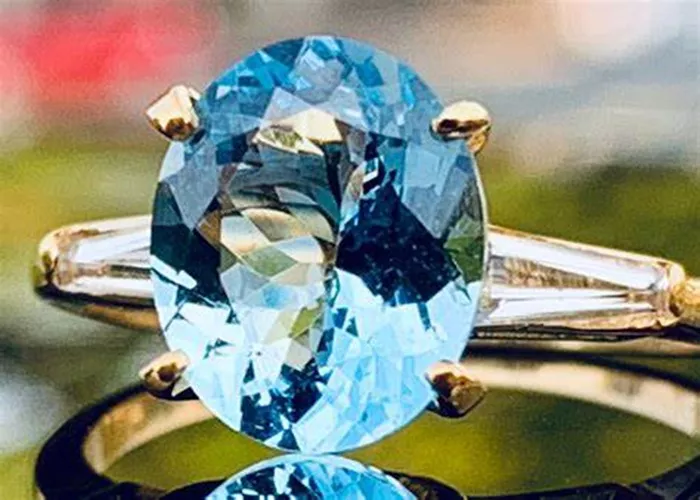Aquamarine is a beautiful gemstone. Its blue color reminds people of the ocean. Many choose it for engagement rings because it is unique. It is also more affordable than diamonds. If you want to build your own aquamarine engagement ring, this guide will help.
Why Choose Aquamarine?
Aquamarine is a type of beryl. Its color ranges from light blue to deep blue-green. The name comes from Latin words meaning “water of the sea.” This gem is durable, with a hardness of 7.5 to 8 on the Mohs scale. It is strong enough for daily wear but still needs care.
Aquamarine is a birthstone for March. It symbolizes courage, clarity, and harmony. Many believe it brings calmness and happiness. Unlike diamonds, aquamarine is less common in engagement rings. This makes it stand out. It is also more budget-friendly. A high-quality aquamarine can cost much less than a diamond of the same size.
Selecting the Perfect Aquamarine
The first step in building your ring is choosing the stone. Aquamarines come in different shapes, sizes, and colors. Here’s what to look for:
Color
The most valuable aquamarines have a deep blue color. However, lighter stones are also beautiful. Some have a slight green tint. The choice depends on personal preference. If you like a pure blue look for stones with less green.
Clarity
Aquamarines usually have few inclusions. High-quality stones are eye-clean, meaning no visible flaws. Avoid stones with cracks or cloudiness. These can weaken the gem.
Cut
The cut affects the stone’s sparkle. Popular cuts for aquamarine include oval, round, emerald, and cushion. The cut should enhance the color and brilliance. A well-cut stone will reflect light beautifully.
Carat Weight
Aquamarines come in various sizes. Larger stones are available but can be expensive. A 1 to 3-carat aquamarine is common for engagement rings. Choose a size that fits your budget and style.
Treatment
Most aquamarines are heat-treated to improve color. This is a standard practice and does not lower value. Always ask if the stone has been treated. Avoid stones with dye or fracture filling.
Choosing the Metal for Your Ring
The metal holds the aquamarine and gives the ring structure. Popular choices include:
White Gold
White gold has a modern look. It pairs well with the blue of aquamarine. It is durable and often coated with rhodium for extra shine.
Yellow Gold
Yellow gold gives a classic, warm look. It contrasts nicely with the cool blue of aquamarine. It is also easy to maintain.
Rose Gold
Rose gold has a romantic pink tone. It creates a soft, elegant look with aquamarine. It is a unique choice for an engagement ring.
Platinum
Platinum is strong and hypoallergenic. It has a natural white shine that does not fade. It is more expensive but lasts a lifetime.
Sterling Silver
Sterling silver is affordable but less durable. It is good for temporary or budget rings. Over time, it may tarnish and need polishing.
Selecting the Ring Setting
The setting holds the stone in place. It also affects the ring’s style and security. Common settings for aquamarine rings include:
Solitaire
A solitaire setting has a single stone. It highlights the aquamarine’s beauty. This is a simple and elegant choice.
Halo
A halo setting has small diamonds or gems around the center stone. This makes the aquamarine look larger and adds sparkle.
Three-Stone
A three-stone ring has a center aquamarine with two side stones. These can be diamonds or other gems. It symbolizes the past, present, and future.
Vintage
Vintage settings have intricate designs. They often include filigree or milgrain details. This style suits those who love antique looks.
Bezel
A bezel setting wraps metal around the stone. It protects the edges and gives a modern look. It is very secure for active wearers.
Pavé
A pavé setting has small diamonds set closely together on the band. It adds extra brilliance without overpowering the aquamarine.
Customizing Your Ring Design
Once you choose the stone, metal, and setting, you can add personal touches.
Engraving
Engrave a name, date, or special message inside the band. This makes the ring unique to your relationship.
Accent Stones
Add small diamonds or colored gems to the band. This enhances the design without distracting from the aquamarine.
Mixed Metals
Combine two metals, like white gold and rose gold. This creates a stylish contrast.
Unique Shapes
Consider unusual shapes like pear, heart, or marquise cuts. These stand out and show personality.
Finding a Jeweler
A good jeweler will help bring your vision to life. Look for someone with experience in custom rings. Check reviews and ask to see previous work. Discuss your budget and timeline. A skilled jeweler will guide you through the process.
Caring for Your Aquamarine Ring
Aquamarine is durable but still needs care. Follow these tips to keep it beautiful:
Cleaning
Clean your ring with warm, soapy water. Use a soft brush to remove dirt. Avoid harsh chemicals that can damage the stone.
Storage
Store your ring in a soft pouch or jewelry box. Keep it away from other pieces to prevent scratches.
Maintenance
Check the prongs regularly to ensure the stone is secure. Take the ring to a jeweler for professional cleaning once a year.
Avoid Impact
Remove the ring during heavy work or sports. Aquamarine can chip if hit hard.
Conclusion
Building your own aquamarine engagement ring is a rewarding experience. You get to choose every detail, making it truly special. Aquamarine offers a unique and meaningful alternative to traditional diamonds. With the right stone, metal, and setting, your ring will be a symbol of love and individuality. Take your time, explore options, and enjoy the process. The result will be a stunning ring that tells your story.
Related Topics:
- The Birthstone for March 28: A Deep Dive into Aquamarine
- Unveiling the Three-Stone Aquamarine Ring: A Dazzling Emblem of Underwater Beauty
- Is Tanzanite Suitable for a Ring?


